Depending on whether you feel more inclined towards art or a lazy wander through the streets of the centre, the Lower Town promises six hours well spent.
We suggest to organise an itinerary that starts at nineteenth century Porta Nuova, and has its exciting conclusion at the Accademia Carrara Art Gallery.
A walk that unwinds from Sentierone towards Via Tasso and Borgo Pignolo, punctuated with remarkable meetings with the likes of Gaetano Donizetti and Lorenzo Lotto.
Depending on whether you feel more inclined towards art or a lazy wander through the streets of the centre, the Lower Town promises six hours well spent.
We suggest to organise an itinerary that starts at nineteenth century Porta Nuova, and has its exciting conclusion at the Accademia Carrara Art Gallery.
A walk that unwinds from Sentierone towards Via Tasso and Borgo Pignolo, punctuated with remarkable meetings with the likes of Gaetano Donizetti and Lorenzo Lotto.

A dip in the sober and classic style of the nineteenth century which is recalled by the two propylaea. Since 1837 they have drawn Largo Porta Nuova, an opening where the historical walls of the customs house once stood.
Walking through them we take you to the heart of the Lower Town. It was designed by the Roman architect Marcello Piacentini in place of the eighteenth-century masonry fair.
A dip in the sober and classic style of the nineteenth century which is recalled by the two propylaea. Since 1837 they have drawn Largo Porta Nuova, an opening where the historical walls of the customs house once stood.
Walking through them we take you to the heart of the Lower Town. It was designed by the Roman architect Marcello Piacentini in place of the eighteenth-century masonry fair.
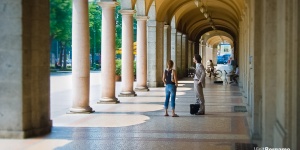
The centre of modern Bergamo is the ideal place to walk in the name of shopping, amusement, art and history!
This ancient and elegant part of the city is called Centro Piacentiniano, an amazing architectural complex that used to host the old city trade fair. This very same atmosphere still enlivens the area, thanks to the numerous markets and events filling the city centre with colours and scents all over the year. Walking along the Sentierone pedestrian way, passing by the imposing chestnut trees and beyond the Porta Nuova propylaea, you will get to via XX Settembre: here you can admire Palazzo Frizzoni, Bergamo’s City Hall.
From here on, enjoy the local life: boutiques, shops, alleys and beautiful small squares, in the name of amusement. Last but not least, how about a good coffee or a drink in one of the numerous cafes and bars?
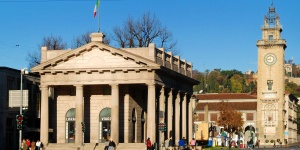
Train is the best way to get to Bergamo: going out of the railway station, you have an immediate and wonderful overview of the city. Your sight follows a straight line going up to Porta Nuova, the heart of the Lower Town. Raise your head just a little bit and your eyes will be filled with the majestic and perfect landscape of the Upper Town.
In 1837, the old wicket gate nestled in the “Muraine”, the massive XV Century walls that used to surround the hills and go down to the Lower Town and the old districts, was replaced by an iron gate opening a breach in the defensive walls: it is Porta Nuova (“New Gate”).
This place represented the main gateway to the commercial area of Bergamo for a very long time. Today, it is still the main junction around which the main streets and monuments of the Lower Town lie.

Time for a refreshment break in one of the elegant cafés around the Quadriportico del Sentierone. Then our walk can start again in the direction of Borgo Pignolo, along Via Tasso.
We meet two art masters along our path. The great Gaetano Donizetti, in which the city’s first theatre is named after, and the immense Lorenzo Lotto, whose works are present in the churches of SS Bartolomeo and Stefano, S. Spirito and S. Bernardino.
Time for a refreshment break in one of the elegant cafés around the Quadriportico del Sentierone. Then our walk can start again in the direction of Borgo Pignolo, along Via Tasso.
We meet two art masters along our path. The great Gaetano Donizetti, in which the city’s first theatre is named after, and the immense Lorenzo Lotto, whose works are present in the churches of SS Bartolomeo and Stefano, S. Spirito and S. Bernardino.
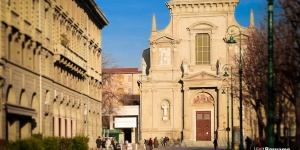
At the end of the eastern end of the Sentierone promenade, you can see the Church of Saints Bartolomeo and Stefano, built for the Dominican Religious Order in the first half of XVII Century, following the plan of the architect Antonio Maria Caneva.
Dominican order was not the first one to live in these places: in fact, the site used to belong to the community of the Order of the Humiliati. Formerly the complex used to consist of a church and some farmhouses.
If you observe the church from the outside you can notice the different construction periods: the façade, imitating a baroque style, was rebuilt in 897, the portico on the left was renovated in 1942, while the side overlooking via Tasso was made during the XIX Century.
The church features one aisle with five chapels on each side. The choir is decorated with beautiful XVI Century inlays, while behind the main altar you can admire the renowned Martinengo Altarpiece by Lorenzo Lotto, dating back to 1516.
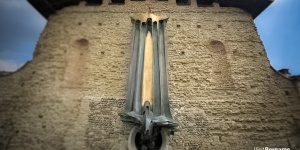
Walking along via Tasso, in the centre of Lower Bergamo, you will surely notice the rough façade of this church, overtopped by the imposing bronze statue of the Holy Ghost descending to the churchyard.
The previous building belonged to a XIV Century monastery. A group of rich merchants in the XVI Century decided to radically transform it in order to establish its social status by means of a church, besides the numerous palaces.
The church renovation took a long time. Over different periods, the two major architects from Bergamo worked on it: Pietro Isabello in the XVI Century and Gian Battista Caniana in the XVIII Century.
Five chapels per side flank the central nave. The fourth one on the right hosts the wonderful Altarpiece (oil on table) by the Italian Renaissance master Lorenzo Lotto, "Madonna and Child with Saint Catherine of Alexandria, St. Augustine, St. Sebastian and St. Anthony Abbot", 1521.
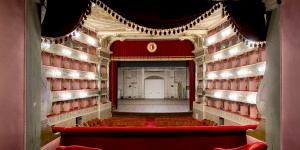
The Teatro Donizetti covers a total area of 3200 square meters. The hall’s dimensions respect the original 1786 design: it measures 360 square meters and it’s able to seat 532 people. There are 120 boxes, divided into three tiers, totalling 1154 seats.
It’s easy to understand how magnificent this building is and how astonished the Bergamo citizens were as they saw it, in an age when there only were small and temporary wooden theatres.
An enormous and sparkling chandelier, with 78 lamps, hangs from the middle of the ceiling, while other sources light up the stage.
Due to its sound harmony and distribution, the theatre is considered one of the best ones in Italy.
Originally named “Riccardi” after its maker, this Theatre is mostly renown as the place where Donizetti’s operas (more than 70!) were spread and appreciated by his fellow citizens.
Try to imagine the emotion experienced by Donizetti in theatre, when the audience assisting to the opera “L’esule di Roma – The exile from Rome”, gave a sincere and warm ovation. This happened in 1840: Donizetti would eventually die of disease in Bergamo a few years later, in his hometown, in 1848.

There are many appetising options for a quick snack before getting caught up in a journey through time and in the pictorial art offered by the recently restored Accademia Carrara Gallery. Works by Lorenzo Lotto, Botticelli, Tiziano, Bellini, Mantegna, Moroni, Piccio and Pisanello await you.
There are many appetising options for a quick snack before getting caught up in a journey through time and in the pictorial art offered by the recently restored Accademia Carrara Gallery. Works by Lorenzo Lotto, Botticelli, Tiziano, Bellini, Mantegna, Moroni, Piccio and Pisanello await you.
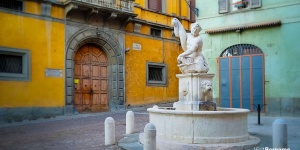
Let’s dive into the deep waters of Lower Bergamo: how is it possible?
Thanks to the beautiful Dolphin Fountain. A strong two-tales triton rides a dolphin by which the water gushes, along with the two deity masks on the column sides.
You will better appreciate the fluid lines of this Fountain by walking around it, admiring the triton’s dynamic pose.
On the other hand, there is also a bas-relief on the Fountain’s base representing a big pinecone, the symbol of the Pignolo borough, one of the most ancient districts of Bergamo.
In the Middle Age, before the Venetian Walls were built, this area was full of wide and lush conifer woods, whose fruit is indeed the pinecone.
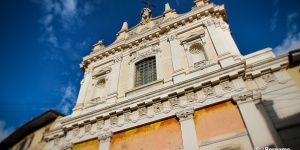
As you walk along via Pignolo, the medieval street connecting the Lower City with the “Città Alta”, you will get to a small square: the church of Sant’Alessandro della Croce is located right there. According to the legend, it was originally built during the time of Alessandro’s martyrdom, in IV Century. However, its interiors were rebuilt between XVII and XVIII Century, while the façade was only completed in 1922.
It is called “della Croce – of the Cross” because it was built at the crossroad among four medieval boroughs.
The Church is decorated with some of the most beautiful paintings in Bergamo. We just mention two masterpieces by Gian Battista Moroni: “Coronation of the Virgin”, located on the counter façade, and Crucifixion with Saint Sebastian, John the Baptist and a devotee” in the sacristies.
There are three chapels on each side of the nave: in the first one you will find an empty urn, which used to be the tomb of Saint Alessandro, whose remains are currently kept in the Cathedral of Bergamo.
On the other side, the second chapel on the right holds a beautiful altar made exclusively of precious multi-coloured marbles, carried out by the master Andrea Fantoni in 1729:a unique work for that time, demonstrating his amazing skills.
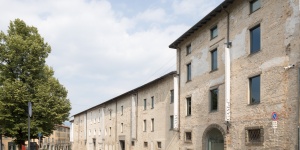
The Gallery of Modern and Contemporary Art was founded in 1991 right in front of the Accademia Carrara Picture Gallery, in a restored fifteenth-century architectural complex, formerly intended as a monastery. The diversified programming - open to experimentation with contemporary languages and to multidisciplinarity, and at the same time anchored to the roots of the institution and its heritage - has made it into a multifaceted space that has been able to involve different audiences over the years. With its 1500 square metres of exhibition space, it is a place that welcomes contemporary art in all its forms: temporary personal and collective exhibitions by international artists, new and emerging projects and a rich calendar of collateral activities designed for different audiences are the strong point of the Gallery’s cultural policy, which is a dynamic place for comparison, analysis and cultural integration, in constant evolution.
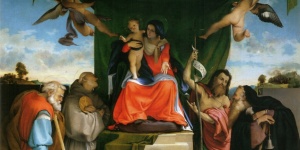
Situated at the entrance of Bergamo’s most aristocratic road, this church was most likely built following the saint’s two visits to the city (1419-1422). Re-consecrated by the bishop in 1593, perhaps after a major restoration, it was decorated throughout the years.
Its neo-Gothic form was created between the nineteenth and twentieth century: a single space, punctuated by 5 bays, 3 of which are believed to be fifteenth-century, with a gabled facade. The altarpiece is the work of Lorenzo Lotto (1521) .
The church is managed by the Parish of Sant'Alessandro in Croce, and the visit is free thanks to the collaboration of the Touring Club Italiano volunteers.
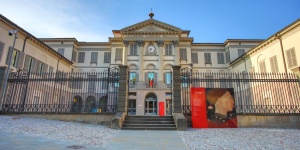
Museum
The Accademia Carrara in Bergamo is a museum with a specific and, in some ways, unique identity, closely tied to its origins and history. Unlike many Italian museums, Carrara is the result of the ambitious project of Giacomo Carrara (1714-1796) to promote the establishment of a cultural institution that would combine pleasure and education, serving as both an art gallery and a painting school. The success of this idea is evidenced by the extensive series of large and small donations made over more than two centuries by individuals and institutions. These, along with a few targeted acquisitions, have complemented the original foundation laid by the founder. Besides Carrara, leading the long list of donors are notable figures such as Guglielmo Lochis, Giovanni Morelli, Federico Zeri, and Mario Scaglia. Their collections form the backbone of the museum and contribute to defining the diverse and articulated character of its heritage.
The renewed visitor's journey is organized in 16 differently-sized rooms, showcasing a total of 350 exhibited works, including paintings, sculptures, medals, and plaques. Visitors thus have the opportunity to embark on a five-century journey through the history of Italian art, from the Renaissance to the nineteenth century, encountering masterpieces by Pisanello, Mantegna, Botticelli, Raphael, Titian, Lotto, Moroni, Hayez, and Pellizza da Volpedo.